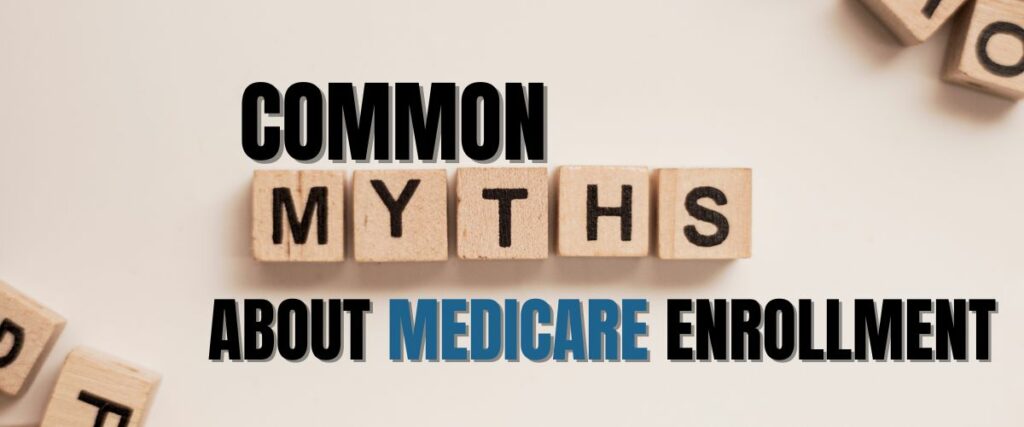Don’t Fall for These 10 Common Medicare Myths When you Enroll at age 65
Medicare is a federal health insurance program for people who are age 65 or older, disabled or have certain medical conditions. It has four parts: A, B, C, and D. Each part covers different types of services and has different costs and rules.
Many people have misconceptions about how to enroll in Medicare and what it covers. Here are some of the most common Medicare myths and the facts that bust them.
Myth 1: You must enroll in Medicare when you turn 65.
Fact: You do not have to enroll in Medicare when you turn 65 and older if you have other health insurance that meets certain standards, such as from your employer or your spouse’s employer. This is one of the top myths about Medicare people have. You can delay enrolling in Medicare without penalty until you lose your other coverage or stop working. However, if you do not have other health coverage or if your coverage is not considered “creditable” by Medicare, you may face a late enrollment penalty if you enroll after your initial enrollment period, which is the seven-month period that begins three months before your 65th birthday month and ends three months after it.
Myth 2: You will automatically enrolled in Medicare when you turn 65.
This is also one of the biggest myths lots of people have before they understand reality.
Fact: You will only be automatically enrolled in Medicare Part A (hospital insurance) and Part B (medical insurance) if you are receiving Social Security or Railroad Retirement Board benefits at least four months before you turn 65. Otherwise, you will have to sign up for Medicare yourself during your initial enrollment period. You can do this online at www.ssa.gov, by phone at 1-800-772-1213, or in person at your local Social Security and Medicare office.
Myth 3: Medicare is free.
Fact: Medicare is not free. You may have to pay premiums, deductibles, coinsurance, and copayments for the services you use. The amount you pay depends on the type of Medicare Plan you choose and the services you need. For example, most people do not pay a premium for Part A, but they do pay a deductible and coinsurance for each hospital stay. Part B has a monthly premium that varies based on your income and a deductible and coinsurance for most services. Part C (Medicare Advantage) and Part D (prescription drug) plans are offered by private companies that contract with Medicare and have different premiums, deductibles, copayments, and coinsurance depending on the plan. You may also choose to buy a Medicare Supplement Plan (also known as Medigap) to help pay some of the costs that Original Medicare does not cover.
Myth 4: Medicare covers everything.
Fact: Medicare does not cover everything. There are some services and items that Medicare does not cover at all, such as dental care, vision care, hearing aids, cosmetic surgery, acupuncture, and long-term care. There are also some services and items that Medicare covers only under certain conditions or with prior authorization, such as skilled nursing facility care, home health care, durable medical equipment, and hospice care. You may have to pay some or all of the costs for these services and items out of pocket or through other insurance.
Myth 5: Time to enroll: You can enroll in any type of Medicare Plan at any time.
Fact: You cannot enroll in any type of Medicare Plan at any time. There are specific times when you can enroll in or change your Medicare Plan. These include:
- Your initial enrollment period: This is the seven-month period that begins three months before your 65th birthday month and ends three months after it. This is when you are eligible for Medicare (Part A and B), a Medicare Advantage Plan (Part C), or a prescription drug plan (Part D) for the first time.
- Your special enrollment period: This is a period that starts when you lose your other health insurance or stop working and lasts for eight months. This is when you can enroll in Original Medicare (Part A and Part B) without penalty if you delayed enrolling because you had other coverage.
- Your general enrollment period: This is the period from January 1 to March 31 each year. This is when you can enroll in Original Medicare (Part A and Part B) if you missed your initial enrollment period or special enrollment period. However, you may have to pay a late enrollment penalty for Part A and/or Medicare Part B.
- Your open enrollment period: This is the period from October 15 to December 7 each year. This is when you can switch from Original Medicare to a Medicare Advantage Plan (Part C), switch from a Medicare Advantage Plan to Original Medicare, switch from one Medicare Advantage Plan to another, enroll in Part D, switch from one prescription drug plan to another, or drop your prescription drug coverage.
- Your Medicare Advantage open enrollment period: This is the period from January 1 to March 31 each year. This is when you can switch from one Medicare Advantage Plan to another or switch from a Medicare Advantage Plan to Original Medicare and enroll in a prescription drug plan (Part D).
Medicare Myth 6: You can only enroll in a Medicare Advantage Plan if you are healthy.
Fact: You can enroll in a Medicare Advantage Plan regardless of your health status. Even if you have ESRD, you can enroll in a Medicare Advantage Plan. Depending on where you live, there may even be a special needs plan that is oriented toward people with ESRD.
Myth 7: You have to enroll in a prescription drug plan if you have Medicare.
Fact: You do not have to enroll in a prescription drug plan if you have Medicare, but it may be a good idea to do so. Prescription drug plans are offered by private companies that contract with Medicare and provide coverage for different drugs at different costs. If you do not enroll in a prescription drug plan when you are first eligible and you do not have other creditable drug coverage, such as from an employer or a union, you may have to pay a late enrollment penalty if you enroll later. The penalty is calculated based on how long you went without creditable drug coverage and the national base beneficiary premium for the year you enroll.
Myth 8: You have to choose between Original Medicare and Medicare Advantage.
Fact: You do not have to choose between Original Medicare and Medicare Advantage. You can switch between them during certain enrollment periods, as explained above. However, you cannot have both at the same time. Original Medicare and Medicare Advantage are two different ways of getting your Medicare benefits. Original Medicare is the traditional fee-for-service program run by the federal government. It covers Part A and Part B services and allows you to see any provider that accepts Medicare. Medicare Advantage is an alternative way of getting your Part A and Part B benefits through a private company that contracts with Medicare. It may also include extra benefits, such as vision, dental, hearing, wellness, and prescription drug coverage. However, it may also have different costs, rules, and restrictions, such as requiring referrals, prior authorization, or network providers.
Myth 9: You can only have one type of Medicare Supplement Plan.
Fact: You can have more than one type of Medicare Supplement Plan, but only if they are different types of plans. For example, you can have a Medigap policy and a retiree health plan from your former employer or union. However, you cannot have two Medigap policies or two retiree health plans at the same time. If you already have one type of supplemental coverage and you want to switch to another type, you will have to drop the first one before enrolling in the second one.
Myth 10: You can get all the information you need about Medicare from the internet.
Fact: The internet is a great source of information about Medicare coverage, but it is not the only source. There are many other ways to get help and guidance about your Medicare options and decisions. These include:
- Calling 1-800-MEDICARE (1-800-633-4227) and speaking to a trained representative who can answer your questions and send you publications.
- Visiting www.Medicare.gov and using the online tools and resources, such as the Plan Finder, the Eligibility & Premium Calculator, and the Compare Quality & Cost Tools.
- Reading the “Medicare & You” handbook that is mailed to you every year or downloading it from www.Medicare.gov/publications.
- Contacting your State Health Insurance Assistance Program (SHIP) and getting free personalized counseling from trained volunteers who can help you understand your options and rights. To find your local SHIP, visit www.shiptacenter.org or call 1-877-839-2675.
- Consulting with a licensed insurance agent or broker who can help you compare and enroll in different types of Medicare Plans. However, be aware that agents and brokers may receive commissions or fees from the companies they represent and may not be able to sell or advise you on all types of plans available in your area.
I hope this summary helps you learn some of the facts about Medicare enrollment at 65 and avoid some of the common myths. Remember, there is no one-size-fits-all solution for everyone. You should consider your own needs, preferences, budget, and situation when making your Medicare decisions.
FAQs
Do I need to enroll in Medicare Part B if I have other health coverage?
Not necessarily. You may delay enrolling for Medicare Part B if you or your spouse are working past 65 and have health coverage from your employer. However, you should sign up for Medicare Part B during a special enrollment period when your employment or coverage ends to avoid penalties.
Does Medicare include prescription drug coverage?
No, it doesn’t. To get coverage for your medications, you need to enroll in a Medicare Part D Plan or choose a Medicare Advantage Plan that includes drug benefits. Many Medicare Advantage Plans offer both health and drug coverage in one plan.
Can I choose any type of Medicare program when I first sign up for Medicare?
Yes, you can. You have a seven-month initial enrollment period (IEP) that starts three months before your 65th birthday and ends three months after. During this time, you can enroll in any type of Medicare Plan, such as traditional Medicare, Medicare Advantage, or Medicare Supplement. You can also switch plans during this period if you change your mind.
Will Medicare cover all my health care costs?
No, it won’t. Medicare covers many services, but not everything. You may have to pay deductibles, coinsurance, copayments, and premiums depending on the type of Medicare Plan you have. You may also have to pay for services that Medicare doesn’t cover, such as dental, vision, hearing, or long-term care.
Do I have to apply for Medicare if I’m already receiving Social Security at age 65?
No, you don’t. If you’re already getting Social Security benefits when you turn 65, you’ll be automatically enrolled in Medicare Parts A and B. You’ll receive your Medicare card in the mail about three months before your birthday. However, if you don’t want Part B, you can opt out by following the instructions on the card.


